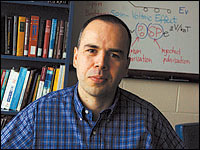Archives
Spintronics is focus of Zutic’s work
New physics faculty member working in emerging field that could revolutionize technology
By JESSICA KELTZ
Reporter Contributor
Igor Zutic, an assistant professor in the Department of Physics, College of Arts and Sciences, focuses his research in the emerging field of "spintronics," which he says could someday revolutionize technology with smaller, faster, more efficient devices.

Igor Zutic says that "spin"
has been completely ignored in the field of electronics. The emerging
field of spintronics may someday revolutionize technology with smaller,
faster, more efficient devices.
PHOTO: NANCY J. PARISI
"I was attracted to UB by the world-class research in nanoscience and by the new hires the physics department has made recently,'' Zutic says, adding that UB also is well-known for work in spintronics, headed by Bruce McCombe, SUNY Distinguished Professor in the Department of Physics and vice provost for graduate education and dean of the Graduate School. McCombe also directs UB's Center for Spin Effects and Quantum Information in Nanostructures (CSEQuIN).
"I feel that the future of the Department of Physics is rather bright and opens up various possibilities for interdisciplinary research," Zutic says.
He holds an undergraduate degree from the University of Zagreb in his native Croatia and a Ph.D. in physics from the University of Minnesota. Before coming to UB this fall, he held postdoctoral appointments at the University of Maryland and a National Research Council Fellowship at the Naval Research Laboratory in Washington, D.C.
Zutic explains the fundamental principle of spintronics by contrasting it with conventional electronics, which relies on the charge of electrons. From early transistors to recent supercomputers, electronic devices employ circuits that express data as binary digits—ones and zeroes represented by the existence or absence of electric charge. Each electron, in addition to charge, has its spin, which is responsible for magnetism.
"This property—spin—has been completely ignored in the field of electronics," he notes. "Paying attention to it can open up an exciting range of opportunities for devices that would not be feasible or effective with conventional electronics."
The spin of an electron is a peculiar quantum property, somewhat analogous to the spinning of a top, he points out. Like a child's top, which spins in a clockwise or in a counterclockwise direction, the spin of an electron can have two directions—"up'' or "down.'' These two spin directions lend themselves to another way of expressing ones and zeroes when storing and processing data, he says.
Successful development of spin-based technology would mean smaller, more efficient devices that use less power because magnetic properties can be preserved, even when the electric power is turned off, he says. While magnetic hard drives in computers are examples of commercial spintronic devices, they represent only a small fraction of what could be possible with spin-based technology, he adds.
Right now, little work has been done toward more ambitious applications, such as spin transistors or spin-based computers, Zutic says. One of the key challenges in the field is developing versatile magnetic materials that could operate at room temperature and be suitable for spin logic, not just for storing information as in magnetic hard drives. Spin logic would use an electron's spin, rather than its charge, to perform complex information processing, he says.
Magnetic materials, which can be viewed as having many spins aligned along the same direction, tend to be fragile at elevated temperatures. Heat, he says, ruins that symmetry of nicely aligned spins in the same way it ruins the symmetry in a snowflake that's heated up and reduced to a drop of water.
However, Zutic remains optimistic that researchers will find a way to develop materials suitable for spin logic, even at room temperature. "Spintronic research still offers many surprises. I anticipate that it will be possible to find a material in which by heating it up, you can actually strengthen or promote magnetism," he says.
His work on spintronics involves both investigating fundamental physical principles and looking into possible novel applications, which has attracted interest from such companies as IBM and INTEL. He recently was awarded a three-year grant from the U.S. Office of Naval Research and a prestigious, five-year, National Science Foundation CAREER award.
In addition to his research, Zutic teaches an introductory physics course that, he says, is taken mainly by students majoring in other scientific disciplines.
Although these students likely won't need to know about physics in depth in their future careers, he says he hopes to leave a more general impression.
"It (the course) should be a way to enhance their curiosity," Zutic says, adding that he wants these students to remember his course when they look at a speeding car or a falling object. "I want to make sure that they think about physics, even when they leave the classroom."
He describes the difference between physics and other sciences as "rather artificial."
"This scientific curiosity that we're trying to stimulate and develop in them (students) should be universal in the various fields that they are trying to master," he says.
Zutic moved to Buffalo with his wife, Sonja Pavlesen, who received a postdoctoral research position in the Department of Social and Preventive Medicine, thanks to support from Uday Sukhatme and Maurizio Trevisan, deans of the CAS, and the School of Public Health and Health Professions, respectively. Zutic says this university-wide respect for dual professional careers cemented his decision to come to UB.
Although they came to Buffalo from Croatia, a charming Mediterranean country, Zutic says he and Pavlesen have found the city to be a pleasant surprise. The rich cultural and artistic life, historic heritage, and warm and pleasant people quickly made them feel at home, he says.
A certified ski instructor who lived in Minneapolis for six years, Zutic says his only initial disappointment in Buffalo has been the weather.
"It's rather warm," he told the Reporter late this fall. "People promised me much more snow."
